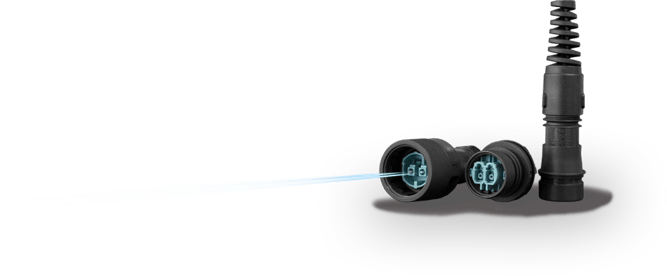Optical fiber is everywhere: carrying huge quantities of data at the speed of light. Glass or plastic, fiber is super-fast, flexible and thin, around the thickness of human hair.
The fiber carries data as pulses of light, and has nowadays overtaken copper wire as the medium of choice – primarily because it is lower cost, faster and less bulky. Optical fiber is also harder to hack than copper, making it more secure and safer because it doesn’t generate heat.
There is, however, a challenge to be overcome: the delicate nature of the optical fiber means installation and maintenance must be carefully managed. Tiny amounts of grease, dirt or moisture can affect the transmission of light. While the fibers themselves are protected by an acrylic layer, the connectors joining each fiber can be vulnerable in harsh environments.
This is particularly true in outdoor applications such as broadcast, telecommunications, civil engineering, FTTx (fiber to the x, including fiber to the home), and marine. Optical fiber must be robust enough to cope with being run between communications masts for telecoms links, across freezing ground for television outside broadcasts, and alongside roads to carry video from traffic cameras.
Damage from freezing temperatures
One specific problem is how the fibers and connectors cope with sub-zero temperatures. Water can make its way into the conduit or duct carrying the fiber, typically if there are any gaps or imperfect joins at the connectors. In fact, standard interface connectors are simply not robust enough to avoid water ingress in harsh environments.
When the temperature drops, the water freezes, and ice forms around the fiber – with the large resulting forces causing the fiber to deform and bend. This degrades the signal passing through the fiber, at the very least reducing the bandwidth, but quite possibly stopping data transmission altogether.
To mitigate this problem, one approach is to only install fiber cables buried below the frost line, so there is no threat of ice. But this solution can be extremely expensive, and is difficult to follow when cables need to be routed along a bridge or other structure. Another solution can be to add antifreeze liquids or gels to the fiber conduit, but again this can have a high cost.
Rugged connectors
If we want to cost-effectively protect an optical fiber against extreme temperatures, it is therefore essential to protect the end points and connections from any water that can leak into the conduit, and later freeze. A suitable connector, which is specifically designed for harsh environments, can ensure the fiber conduit is sealed, and the fiber itself is safe from the risk of ice formation.
There are three common types of fiber connectors: SC, ST (bayonet-twist) and LC (push-pull locking). The LC connector is most commonly chosen, because it is much smaller than the other two, and also provides a secure clip connection.
Unfortunately, the standard LC connector does not provide sufficient protection against water ingress. It is possible to build a custom enclosure to protect a connector, but this is usually bulky and costly.
Instead, a much better approach is to specify a rugged LC connector that is specifically designed for harsh environments. For example, Bulgin’s 4000 Series Fiber connector is the smallest sealed standard interface connector on the market. The fiber connection is UV resistant, salt spray resistant and sealed to IP66, IP68 and IP69K, while still providing an industry-standard LC interface as specified by IEC 61754-20.
The connector and its housing can be completely immersed in water up to a depth of 10 meters, for a period of up to two weeks (based on IP68 rating tests), without allowing water to gain access to the conduit and hence potentially to freeze and damage the fiber. The connector can also handle temperatures from -25 to +70c and protects the fiber against dirt and dust.
4000 Series Fiber Simplex Connector
4000 Series Fiber product code: PXF4050
For duplex fiber connections, the 6000 Series Fiber would be more fitting. Like the 4000 Series Fiber, the 6000 Series Fiber connector is suited for outdoor broadcasting, FTTx, server room engineering, civil engineering and aviation & rail applications.
The 6000 series harsh environment optical connector is designed for years of service in areas where unprotected physical contact fiber, isn’t an option. Featuring a secure, yet easy to operate 30 degree locking mechanism, this series has field proven IP68 and IP69K performance.
In comparison to the simplex 4000 Series Fiber connector, the additional glass fiber on this duplex cable can double the data transmission capabilities where required.
6000 Series Fiber Duplex Connector
6000 Series Fiber product code: PXF6050
With a suitable rugged connector, engineers can now plan their fiber deployments in harsh environments without fear of damage from ice – and without the cost of antifreezes, or the inconvenience of bulky enclosures.
Visit Bulgin’s Connectivity Community forum and blog for expert advice on optical fiber connectors and installations in harsh environments.


